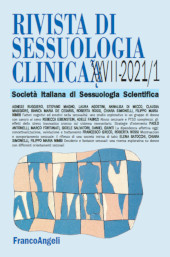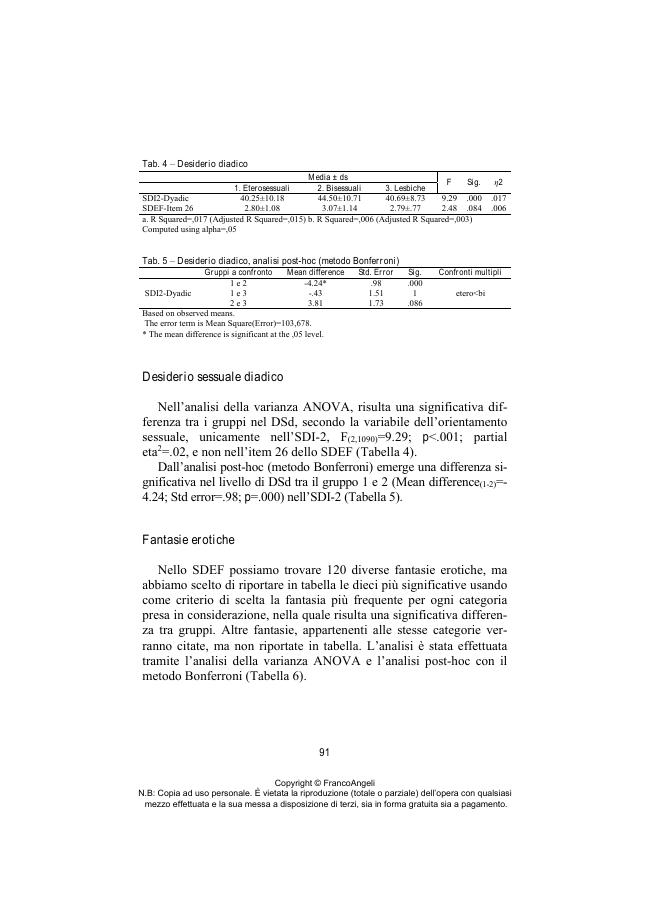2021 - Franco Angeli
Articolo
Versione Digitale
Download | Copia/incolla | Stampa
Desiderio e fantasie sessuali : una ricerca esplorativa su donne con differenti orientamenti sessuali
81-101 p.
- Il desiderio sessuale rappresenta la fase più complessa e soggettiva della risposta sessuale e le fantasie erotiche sono una delle sue manifestazioni più comuni. Negli anni si è cercato di promuovere un approccio più positivo e informato alla sessualità e il seguente studio ha l'obiettivo generale di esplorare se e come desiderio e fantasie sono state modificate in questo processo. Sono stati indagati il desiderio sessuale, solitario e diadico, e le fantasie erotiche in un gruppo di donne con lo scopo di evidenziare eventuali differenze tra alcuni orientamenti (eterosessuale, bisessuale e omosessuale). La ricerca fa parte di un progetto più ampio, che ha come obiettivo la validazione di un nuovo questionario: il Sexual Desire and Erotic Fantasy Inventory (SDEF). Le donne che hanno preso parte alla ricerca sono state 1094, con un'età compresa tra i 18 e i 78 anni e un orientamento eterosessuale, bisessuale e omosessuale.
- Gli strumenti utilizzati sono stati: un questionario per la raccolta dei dati sociodemografici, l'SDI2 e lo SDEF. I risultati riportano delle differenze significative tra gli orientamenti sessuali, con un maggiore livello di desiderio sessuale solitario (SDI2: F(2,1090)=28.14; SDEF: F(2,1091)=26.93) e diadico (SDI2: F(2,1090)=9.29) nelle donne bisessuali, che sembrerebbero riportare anche una frequenza più alta in quasi tutte le fantasie presenti nello SDEF. [Testo dell'editore].
- Sexual desire represents the most complex and subjective part of the sexual response and erotic fantasies are one of its common manifestation. Over the years, efforts have been made to promote a more positive and informed approach to sexuality and the following study has the general aim of exploring whether and how desire and fantasies have been changed in this process. The study inquires sexual desire, solitary and dyadic, and the erotic fantasies in a group of women with the aim of highlighting any differences between some sexual orientations (heterosexual, bisexual, and homosexual). Methods: participants were recruited by social network (Instagram, Facebook, etc.) and voluntarily agreed to fill in an online selfreport questionnaire. The group is composed by 1094 women (mean age 27.86 ± 9.09 years) with three different sexual orientation, most of them are students and in a relationship.
- We used three different questionnaires: a sociodemographic questionnaire, the Sexual Desire Inventory2 (SDI2; Spector et al., 1996) to investigate levels of solitary and dyadic sexual desire, and the Sexual Desire and Erotic Fantasy Inventory (SDEF) to investigate levels of solitary and dyadic sexual desire and the erotic fantasies. Results: bisexual women report a higher level of solitary sexual desire (SDI2: F(2,1090)=28.14; SDEF: F(2,1091)=26.93) and dyadic sexual desire (SDI2: F(2,1090)=9.29). They also report a higher frequency in almost all erotic fantasies presented by SDEF, For example, in BDSM fantasies (Bondage - Domination/Discipline - Submission/Sadism - Masochism) such as "being handcuffed, bound and/or gagged" (F(2,1994)=16.821), "being hit (spanked, slapped etc.)" (F(2,1994)=15.407) and "being dominated/submissive" (F(2,1994)=18.934) bisexual women report a higher frequency, as well as in fantasy "having sexual intercourse with two people" (F(2,1994)=44.180).
- The results highlight a significative difference between the three groups in the solitary sexual desire with a higher level in bisexual women. In the dyadic sexual desire levels, there is a difference only between bisexual and heterosexual women. From the analysis of the erotic fantasies, it emerged that bisexual women report a higher frequency in almost all the 120 fantasies on the SDEF list. The results show that women's fantasies tend to be more personal, with imaginary partners they are in relationship with or know about. This study can be a valuable springboard for future research in the field of erotic fantasies, where women are even less taken into consideration. [Publisher's text].
Fa parte di
Rivista di sessuologia clinica : 1, 2021-
Informazioni
Codice DOI: 10.3280/RSC2021-001005
ISSN: 1972-5183
PAROLE CHIAVE
- Desiderio sessuale, fantasie erotiche, donne, bisessualità, omosessualità, SDEF
- sexual desire, erotic fantasies, women, bisexuality, homosexuality, SDEF
-
Nello stesso fascicolo
- Fattori cognitivi ed emotivi nella sessualità : uno studio esplorativo in un gruppo di donne con cancro al seno
- Abuso sessuale e PTSD complesso : gli effetti dello stress traumatico cronico sul sistema immunitario : strategie d'intervento
- La dipendenza affettiva oggi : concettualizzazione, valutazione e trattamento
- Mestruazioni e comportamento sessuale : il riflesso di una società intrisa di tabù
- Desiderio e fantasie sessuali : una ricerca esplorativa su donne con differenti orientamenti sessuali
- Segnalazioni bibliografiche
- Convegni



